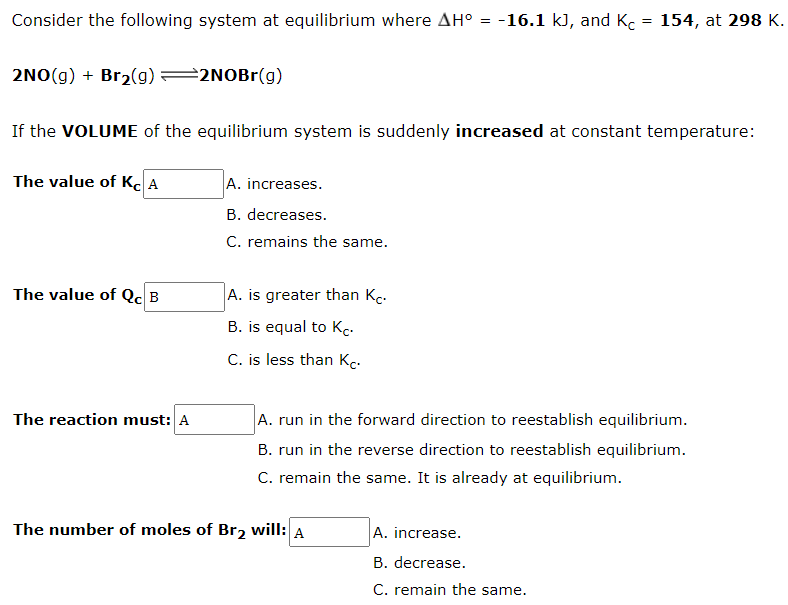Consider the following system at equilibrium where AH° = -16.1 k), and K. = 154, at 298 K. 2NO(g) + Br2(g) =2NOB1(g) If the VOLUME of the equilibrium system is suddenly increased at constant temperature: The value of K. A A. increases. B. decreases. C. remains the same. The value of Qc B A. is greater than Kc. B. is equal to Kc. C. is less than K..
Consider the following system at equilibrium where AH° = -16.1 k), and K. = 154, at 298 K. 2NO(g) + Br2(g) =2NOB1(g) If the VOLUME of the equilibrium system is suddenly increased at constant temperature: The value of K. A A. increases. B. decreases. C. remains the same. The value of Qc B A. is greater than Kc. B. is equal to Kc. C. is less than K..
Chemistry: Principles and Reactions
8th Edition
ISBN:9781305079373
Author:William L. Masterton, Cecile N. Hurley
Publisher:William L. Masterton, Cecile N. Hurley
Chapter12: Gaseous Chemical Equilibrium
Section: Chapter Questions
Problem 56QAP: Sulfur oxychloride, SO2Cl2, decomposes to sulfur dioxide and chlorine gases. SO2Cl2(g)SO2(g)+Cl2(g)...
Related questions
Question
kindly check my answer? thank you!

Transcribed Image Text:Consider the following system at equilibrium where AH° = -16.1 k), and K. = 154, at 298 K.
2NO(g) + Br2(g) =2NOB1(g)
If the VOLUME of the equilibrium system is suddenly increased at constant temperature:
The value of K. A
A. increases.
B. decreases.
C. remains the same.
The value of Qc B
A. is greater than Kc.
B. is equal to Kc.
C. is less than Kc.
The reaction must: A
A. run in the forward direction to reestablish equilibrium.
B. run in the reverse direction to reestablish equilibrium.
C. remain the same. It is already at equilibrium.
The number of moles of Br2 will: A
A. increase.
B. decrease.
C. remain the same.
Expert Solution
This question has been solved!
Explore an expertly crafted, step-by-step solution for a thorough understanding of key concepts.
Step by step
Solved in 3 steps with 1 images

Knowledge Booster
Learn more about
Need a deep-dive on the concept behind this application? Look no further. Learn more about this topic, chemistry and related others by exploring similar questions and additional content below.Recommended textbooks for you

Chemistry: Principles and Reactions
Chemistry
ISBN:
9781305079373
Author:
William L. Masterton, Cecile N. Hurley
Publisher:
Cengage Learning

Chemistry: An Atoms First Approach
Chemistry
ISBN:
9781305079243
Author:
Steven S. Zumdahl, Susan A. Zumdahl
Publisher:
Cengage Learning

Chemistry
Chemistry
ISBN:
9781305957404
Author:
Steven S. Zumdahl, Susan A. Zumdahl, Donald J. DeCoste
Publisher:
Cengage Learning

Chemistry: Principles and Reactions
Chemistry
ISBN:
9781305079373
Author:
William L. Masterton, Cecile N. Hurley
Publisher:
Cengage Learning

Chemistry: An Atoms First Approach
Chemistry
ISBN:
9781305079243
Author:
Steven S. Zumdahl, Susan A. Zumdahl
Publisher:
Cengage Learning

Chemistry
Chemistry
ISBN:
9781305957404
Author:
Steven S. Zumdahl, Susan A. Zumdahl, Donald J. DeCoste
Publisher:
Cengage Learning


Chemistry & Chemical Reactivity
Chemistry
ISBN:
9781337399074
Author:
John C. Kotz, Paul M. Treichel, John Townsend, David Treichel
Publisher:
Cengage Learning

Chemistry & Chemical Reactivity
Chemistry
ISBN:
9781133949640
Author:
John C. Kotz, Paul M. Treichel, John Townsend, David Treichel
Publisher:
Cengage Learning